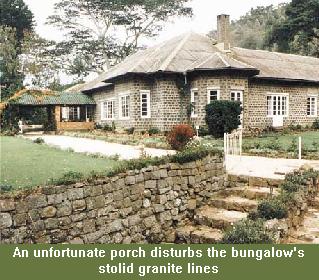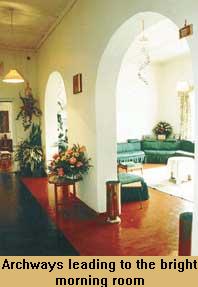

![]()
Why, you wonder, is there a swimming pool in the garden of a bungalow where it is so chilly there is a fireplace in the sitting room? But neither pool nor fireplace is used these days at the Craig Bungalow, near Bandarawela.
The pool is empty and forgotten, sadly, like an old love affair. The garden, too, seems to have memories of happier days judging by the presence of a huge clump of bougainvillea whose branches spread over the lawns resembling those of a venerable oak. A sun kiosk with wooden benches reminds us of an era when people had time to enjoy a garden’s moods.
 The
flowers climbing over the porch, as though trying to hide its ugliness, testify
to the efforts of someone who wanted the garden to be worthy of Craig’s
gallant granite facade. The bungalow is built in the style popular in this area
just before the 1920s, as the railway line penetrated from Colombo. Even the
tiny Ella railway station, built in 1918, has the same stolid granite air.
The
flowers climbing over the porch, as though trying to hide its ugliness, testify
to the efforts of someone who wanted the garden to be worthy of Craig’s
gallant granite facade. The bungalow is built in the style popular in this area
just before the 1920s, as the railway line penetrated from Colombo. Even the
tiny Ella railway station, built in 1918, has the same stolid granite air.
The porch, of course, was added later, a symptom of the notion that people should not get wet when alighting from a car at their front door. So different from the age when travel was by horseback or cart. Ferguson’s Directory tells us that Craig was five miles by cart road from bandarawela and a mile and half less by short cut by horse through the hills.
Disregarding the unfortunate porch, the bungalow looks as impressive as when it was built. At either side, defining its two wings, are pentagon shaped, granite block arbours with a door in each opening onto the garden. One forms part of the sitting room and four of its five sides are furnished with banquettes typical of the 1920s.
The sitting room itself has a rich teak parquet floor lending it a formal appearance. In the days when the fireplace was used for a log fire, it would have given cosy comfort to its British planter occupant and his family. Were they the hardy ones who built the swimming pool?
 >An
unusual feature of the bungalow is the bright morning room without doors, only
open arches giving access from the central corridor to its inspiring
spaciousness. There are more banquettes providing fixed seating. Brass objects
like upturned shells, often seen as decoration in plantation bungalows, are used
at Craig to accentuate the arches. They come from old spray packs.
>An
unusual feature of the bungalow is the bright morning room without doors, only
open arches giving access from the central corridor to its inspiring
spaciousness. There are more banquettes providing fixed seating. Brass objects
like upturned shells, often seen as decoration in plantation bungalows, are used
at Craig to accentuate the arches. They come from old spray packs.
To solve the problem of filling empty corners in this big house, the current occupants have turned to nature. Huge arrangements of flowers add colour to dull corners while items of object trouve, such as oddly shaped tree roots and branches, delight the eye.
The bungalow’s two wings embrace an inner garden, with corridors at either side of the dining room linking them.
The dining room is located opposite the bungalow’s entrance and its main door has been blocked off. Here some of the original bungalow furniture is to be found.
The dining table has two sections that can be removed to reduce it to a more intimate size. It has eight chairs of unusual design with added elbow rests on their arms. They have been enhanced by someone’s daring in having them upholstered in red. Other pieces include a sideboard with a hinged top, used as a liquor cabinet.
A practical feature is the serving hatch of teak set into the side corridor wall and used for passing dishes conveniently from the pantry at the far end of the corridor. An old water filter stands in the corridor beside it.
Another piece that has survived the many changes in occupants over the years is a card table.
These are often found in estate bungalows, remaining from the days when planters relaxed with friends rather than relying on television for company. The card table is a folding one with a swiveling top and probably dates from the more leisurely, sociable times when the swimming pool was added.
The elevation of the Craig Plantation rises from 3,700 to 6,375 feet above sea level and the 775 acres of tea benefit from contrasting climates. So perhaps the hardy planter who many years ago decided to build the swimming pool at such a height, did so in anticipation of the modern temperature changes wrought by global warming.
Return to the Plus contents page
![]()
| HOME PAGE | FRONT PAGE | EDITORIAL/OPINION | NEWS / COMMENT | BUSINESS
Please send your comments and suggestions on this web site to
info@suntimes.is.lk or to
webmaster@infolabs.is.lk